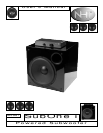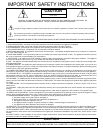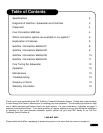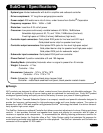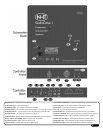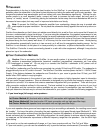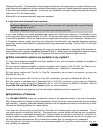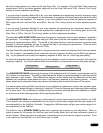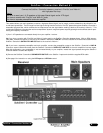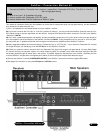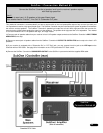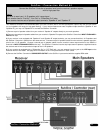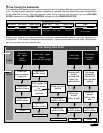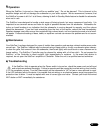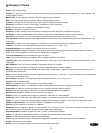
about the same frequency you have set the High Pass Filter. For example, if the High Pass Filter sends only
signals above 75Hz to your main speakers, begin with the Low Pass Filter set at 75Hz. See the “Fine Tuning”
section for further adjustment guidelines.
If you are using Connection Method #2 or #4, your main speakers are reproducing the entire frequency range
(including bass) and it is advantageous for the subwoofer to reproduce only those frequencies below the rated
response of the main speakers. For example, if your main speakers have a rated low frequency response of
60Hz, begin with the Low-Pass Filter set at 60Hz. See the “Fine Tuning” section for further adjustment guide-
lines.
If you are using Connection Method #3, your main speakers are reproducing only frequencies above 100Hz,
due to the fixed 100Hz high pass filter at the speaker-level output barrier strip. As a starting point, set the Low
Pass Filter at 100Hz. See the “Fine Tuning” section for further adjustment guidelines.
The selectable HIGH PASS FILTER determines the range of frequencies that the main speakers (“satellites”)
will reproduce. For example, a high pass setting of 50Hz means that the main speakers receive a signal con-
taining only frequencies above 50Hz. The benefit of high pass filtering is improved dynamic range and lower
distortion in the main speakers, as they are spared the task of low frequency reproduction. There are three
available high pass settings: 50Hz, 75Hz and 110Hz.
The High Pass Filter should initially be set to a frequency above the rated low frequency limit of the main speak-
ers. For example, if your speakers have a rated low frequency response of 40Hz, use the 50Hz high-pass set-
ting. If your speakers have a rated low frequency response of 90Hz, use the 110Hz high-pass setting.
To select the appropriate high pass setting for your main speakers, check the owner’s manual for their rated low
frequency response. If you are unable to obtain this information, here are some common high-pass settings:
The SUBWOOFER PHASE selector sets the phase of the subwoofer at the 0° position (normal phase) and the
180° position (reverse phase). The ability to adjust subwoofer phase is a great advantage for achieving smooth
bass response in your system. The combined low frequency sound waves from the subwoofer and the main
speakers can sometimes cause peaks and dips in the frequency response at the listening position. In these
cases, adjusting the subwoofer phase may improve the blending and overall performance of the system.
The optimal phase setting will differ according to room conditions and placement, and the main speakers used.
Experiment with phase settings by listening to a familiar CD from the listening seat, alternating phase settings
on the same track. Do not attempt to evaluate the best sound while standing above the subwoofer or amplifi-
er, as the sound at the listening position will be significantly different.
The SUBWOOFER GAIN switch allows you to attenuate the line-level input sensitivity of the SubOne i by 10dB.
This is useful if your receiver or preamplifier has very high line-level output voltage that limits your range of vol-
ume adjustability on the SubOne i Controller. Engaging the 0dB attenuation will give you a wider range of vol-
ume adjustment for the SubOne i.
The SubOne i has a STANDBY MODE feature that is automatic and requires no user adjustment. When no
signal is present for 45 minutes, the SubOne i goes into Standby Mode, and it will use a minimum of power to
remain “asleep.” When the system is used again, it immediately turns on as soon as a signal is received. There
is no need to turn the SubOne i on and off every time it is used.
Small speaker
Medium speaker
Large speaker
110Hz 75Hz 50Hz
7



